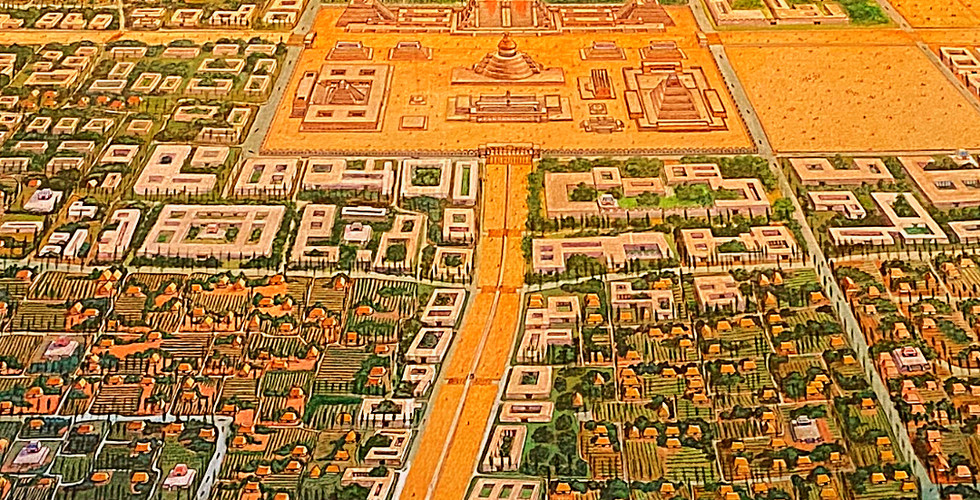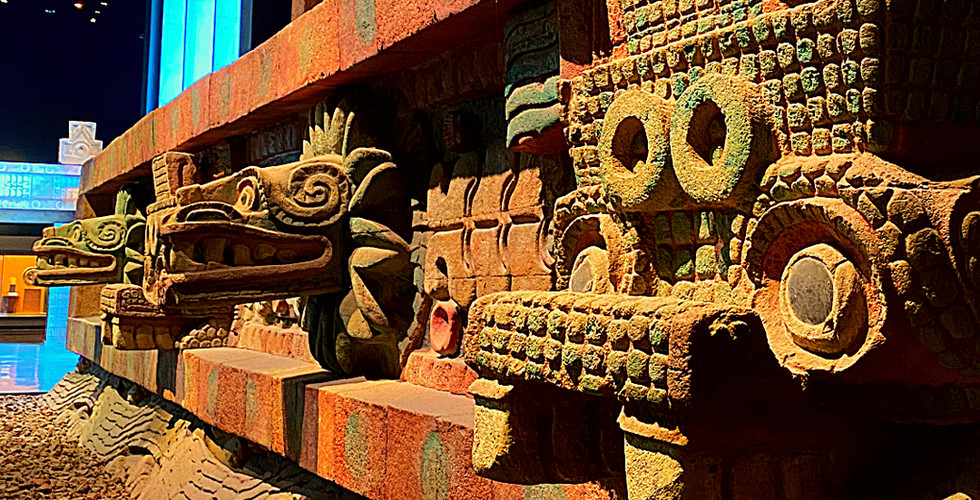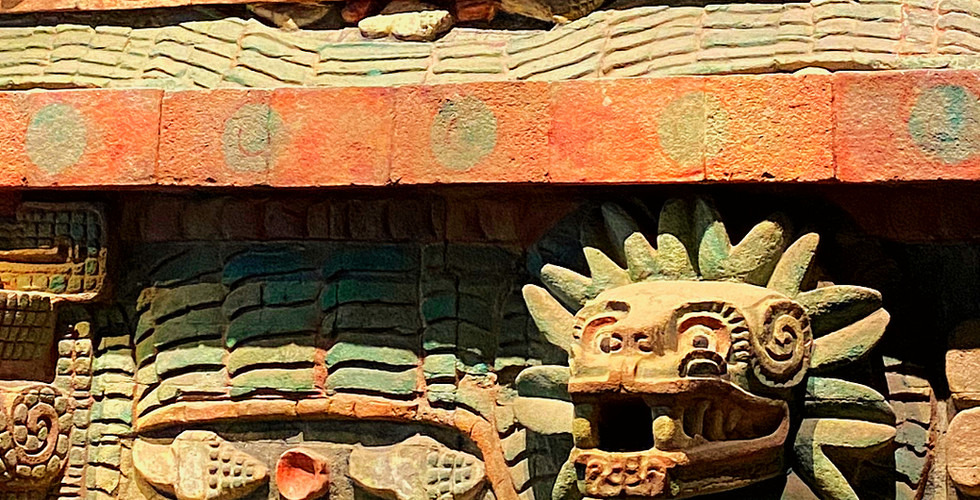Mexico City Pyramids: Unearthing Ancient Wonders in the City of Gods By Backpacker’s Blueprint
- Jack Thompson
- Feb 1
- 12 min read
Updated: Feb 12
In the heart of Mexico City and its outskirts lie some of the world’s most extraordinary architectural wonders; the pyramids. These awe-inspiring structures are more than relics of ancient civilisations. They’re the blueprints of human ambition, spiritual devotion, and architectural mastery.
From the towering grandeur of Teotihuacan to the symbolic remnants of Templo Mayor and the volcanic mystery of Cuicuilco, each site offers a glimpse into a world where architecture wasn’t just about structures; it was about storytelling. Let’s dive deeper into the design, construction, and cultural significance of these pyramids.
CONTENT LINKS
Mexico City Exploration Map
Mexico City Pyramids on the Map
The green items on the map are the Backpacker's Blueprint curated choice of top architecture sites, find them at 10 best pieces of architecture in Mexico City and consider adding them to your list. Now to to Mexico pyramids.
No.1. Teotihuacan: The Pyramid City

Estimated Dates of Construction
Teotihuacan was established around 100 BCE and flourished between 200-550 CE. The Pyramid of the Sun, its largest structure, was completed by 200 CE, while the Pyramid of the Moon was finished around 250 CE. Archaeologists believe the city's decline began around 600 CE, but its influence on Mesoamerican architecture lasted centuries.
Architectural Design & Construction
The pyramids are built using sun-dried adobe bricks, volcanic stone, and lime plaster. The Pyramid of the Sun, rising 65 metres (213 feet), rests on a square base measuring 220 metres (720 feet) on each side. Its alignment with the setting sun during the summer solstice suggests a strong connection to celestial events.
The Pyramid of the Moon, though smaller at 43 metres (141 feet), is situated on higher ground, creating a perfect visual balance when viewed from the Avenue of the Dead. Its design mirrors the contours of Cerro Gordo, a nearby mountain, symbolising the sacred connection between the earth and the cosmos.
The Avenue of the Dead
This grand, 2.5-kilometre avenue served as the city’s ceremonial core, connecting the pyramids and surrounding plazas. The avenue’s width and alignment underscore the planners’ mastery of urban scale and geometry.
Purpose and Use
These pyramids weren’t tombs but platforms for rituals. The Pyramid of the Sun likely served as a site for sacrificial ceremonies to honour the sun, while the Pyramid of the Moon was dedicated to the Great Goddess of Teotihuacan, associated with fertility and water. Excavations have revealed remains of human and animal sacrifices at the summit platforms, reinforcing their ritualistic significance.
2. Templo Mayor: The Sacred Heart of Tenochtitlan
Dates and Phases of Construction
The Templo Mayor, constructed around 1325 CE when Tenochtitlan was founded, was expanded over six phases until its destruction in 1521 CE by Spanish conquistadors. Each phase added height and detail, reflecting the Aztecs’ growing power and wealth. The archaeological site is a stones throw away (excuse the pun) from the site of the Parroquia de la Asunción Sagrario Metropolitano, which uses stone taken directly from the Aztec site.
You can find out more on this on my blog on a day trip to 3 architectural sites to explore in Mexico City. For me, the archaeology site is not the best place to explore the Templo Mayor. Whilst that sounds ridiculous I know, in this humble architect and history lovers opinion, the best place to get a deep insight into Tenochtitlan and the Templo Mayor is at Museo Nacional de Antropología. I took the images above in the museum, the reconstruction of the temples are fantastic.
Another thing to take into consideration is that if like me you tend to do a walking tour through a Guru free walking tour or a pay before you play paid guide (links are recommended tours), as one of the first things you do when you get to a new city, then your guide will talk about the archaeological site and its relationship in context to Mexico City.
I am not trying to put you off paying to go and walk amongst the ruins please do, but, I personally feel you are better doing a walking tour, hitting the museum, and doing a day trip to Teotihuacan. That said, the museum attached to Teotihuacan is home to more than 3,000 artifacts of Mexica culture. With exhibits on offerings, burials and the stages of construction of the site, as well as objects from the colonial occupation. Here is a link to the museum to help with your decision making.
For me the Museo Nacional de Antropología is the absolute must visit when in Mexico City. The architecture of the museum is a modern treat that sits is total contract to the historic exhibits. I have hit many museums in my time but this one really sticks in my mind. If you are here at Backpacker's Blueprint then you are probably looking for an extra layer of knowledge so book in a tour with a historian. If you want insights but are on a tighter budget then a slightly larger group with a guide is still a fantastic option. You can do it yourself, just give yourself a good half a day to explore this museum. I will put a cheat sheet Itinerary together below for this. Now back to the architecture of the Templo Mayor.
Architectural Design & Symbolism
Unlike Teotihuacan’s pyramids, the Templo Mayor is a twin temple pyramid (see images above), with two shrines at the top; one for Huitzilopochtli, the god of war and sun, and another for Tlaloc, the god of rain and agriculture. Each shrine sat atop separate staircases, painted bright red and blue to represent fire and water.
Symbolism
The pyramid symbolised the Aztec cosmology. Its dual temples represented the balance of opposing forces; fire and water, war and fertility. The stairs descending from the shrines symbolised the path of sacrificial offerings flowing to the earth.
Purpose and Use
The Templo Mayor was the epicentre of Aztec religious life. Sacrificial ceremonies were common, with prisoners of war and other offerings made to appease the gods. During the spring equinox, the sun aligned perfectly with the temple, enhancing its sacred significance.
Materials and Construction
Built from volcanic stone and stucco, the pyramid was covered in elaborate carvings and sculptures. Artefacts like the Coyolxauhqui Stone, depicting the dismembered moon goddess, and Tlaltecuhtli Monolith, a massive earth deity sculpture, highlight the Aztecs' artistic and symbolic craftsmanship.
No.3. Cuicuilco: The Round Pyramid of Fire
Dates of Construction
Cuicuilco predates both Teotihuacan and the Aztecs, with construction beginning around 700 BCE. The city was abandoned around 200 CE due to a volcanic eruption from nearby Xitle Volcano, which covered much of the area in lava.
Architectural Design & Distinctiveness
The Cuicuilco pyramid is unique among Mesoamerican pyramids for its circular shape. This form likely symbolised the cyclical nature of time and the universe, concepts deeply rooted in early Mesoamerican beliefs.
Materials
The pyramid was constructed using stone and clay, then covered in stucco. The design features terraces and steps leading to the summit, which once housed ceremonial structures or altars.
Purpose and Use
Archaeologists believe Cuicuilco was a significant ceremonial and astronomical site. Its alignment with celestial bodies suggests that it was used to track solar and lunar movements. The pyramid’s circular shape also connects to fire rituals, symbolising the eternal cycles of life and renewal.
Is it worth a visit? It is a unique offering, a round style pyramid/ temple however its quite a way south of the city, I feel if you are on a tight time line then there are a lot more important and exciting sites to explore with your time in Mexico City.
That said ... If you live in Mexico city or have extended time here then why the heck not. There is a little museum on site and its a total out lier so you will be stepping onto a much lesser travelled site. You could couple it with the contemporary arts museum nearby and have a day of history vs contemporary.
Architecture Beyond the Stones: The Human Connection
The beauty of Mexico City’s pyramids lies not just in their design but in their ability to connect us to ancient humanity. These structures were built by societies that used architecture to express their values, beliefs, and aspirations.
At Teotihuacan, the meticulous urban planning speaks to a civilisation deeply in tune with the cosmos.
At Templo Mayor, the vibrant colours and dual temples reflect the Aztecs’ worldview, balancing war and agriculture, fire and water.
At Cuicuilco, the unique circular design reminds us of life’s cycles and the power of resilience in the face of natural disasters.
These pyramids are a testament to how architecture transcends time, telling stories that resonate across centuries.
The Perfect 2 Day Itinerary for Mexico City
Below you will find links to the Backpacker's Blueprint recommend tours for an immersive cultural journey into the Aztec, Spanish and the modern architecture of Mexico City. You will also find the very best and safest places to stay for small, medium and large budgets. From me this is the perfect 2 days in Mexico City.
Reserve the options in advance below to make sure you do not miss out but with all the security of a cancellation and pay later policy.
2 Days in Mexico City
Day 01 - 5:30am Start
Teotihuacan
$140USD - Teotihuacan Breakfast & Sunrise Hot Air Ballon Tour
Experience the site in golden light with an expert guide. After the balloon tour you will have the option to explore Teotihuacan (85 Pesos entry) or head back to the city centre.
$50USD - Teotihuacan guided tour only
If early mornings and heights are not your thing, or if you are keeping an eye on your budget, then fear not you can still get an early start with a guided tour. You will get an extra hour in bed to keep you fresh as this will be a long but fruitful day.
Early Afternoon - 12:30pm
Palacio Bella Artes
This place is a true stunner and a must visit for you architecture lovers. The art work internally changes with some staple mural pieces, which I loved, however the art in the building is not the only thing to be looking at, the art deco interior is absolutely gorgeous. The entry price here is $95.00 MXN per person, you will need to queue for a ticket. Spend an hour or 2 milling about and have some time walking around the park to take in some sculptures and fountains and some street performances, Make sure to take the weight off your feet in preparation for the next activity.
Take note of the metro station, you will see art nouveaux (french inspired) metal railings and font types, really beautiful. You will learn more about this during the walking tour.
Also use this time to grab some lunch and a coffee, the best place to do this is down Av Francisco I. Madero. This is main pedestrian walk way diagonally oposite the Palacio Bella Artes, down here you will find everything from cafes to fast food options.
Afternoon - (2:15pm)
Historic Centre Walking Tour
$10+ USD - Mexico City Walking Tour - The Best Introduction (Kactus Tours)
A walking tour of the historic centre of Mexico City is a vital piece of the intelligent explores itinerary. You will learn of Aztec, Spanish and even french architecture as well as modern interventions. Enjoy the tour and relax knowing you have a knowledgable guide showing you around the City Centre.
Early Evening - 4pm to 5pm Dinner
Dinner before sunset views
I am going to suggest here that you talk to your guide and ask for a local recommendation for a dinner spot before heading to our next location.
Evening - 6pm or 8pm - Check Sunset Time
Head across to the Torre Latino Americano and buy a ticket for the museum and viewing deck ($230 Pesos). After a day of learning about Mexico City you do not have to worry about this building sinking as its foundation design is extensive. Head up to the viewing platform to watch day turn to night over Mexico City.
Head back to your hotel or hostel for a well earned drink and get ready for another busy one tomorrow.
Day 02 - 8am or 9:30am Start
Museo de anthropology
Goooood morning and welcome to day two. We can have a little bit more of a leisurely start today, grab breakfast in your accommodation and book an Uber in to get you to the Museo de anthropology for either 8:50am or 10:20am. Purchase you ticket for the museum ($100 Pesos). Then team up with your guide and get ready to discover Mayan and Aztec history.
$73.17USD - Tour with Historian (later start - 10:20am)
$29USD - Group guided tour (early start - 8:50am)
Look, the truth is you could spend 2 days in this place which is why a guide is going to be vital to success but lets say 3 hours here and then add half an hour on to grab some food and a coffee from the on site cafe, you are going to need it to fuel your brain as you will be inundated with the history of Mexico and we are about to take a walk.
Noon
Chapultepec Castle
Once you have finished in the Museo de anthropology, we are going to walk over to Chapultepec Castle. Winding your way through the park and then up the hillside Chapultepec Castle is a Navy museum, but also a stunning piece of architecture. Up on the hilltop you are able to get beautiful views back over the commercial district of Mexico City.
Afternoon - 3:oopm
Frida Kahlo Museum
Time for your next Uber. Once you are finished at the castle the next must stop (and I select this knowing there are two incredible art museums in walking distance here), however for me as a must visit to keep you immersed in the best of Mexico culture, head across to the Frida Kahlo Museum. This is an absolute must book in advance as it is small and extremely popular. The best place to book tickets here is straight at the source (usually up to a month in advance). This ticket also gives you access to the Diego Rivera-Anahuacalli Museum in
Coyoacán. This one is more artefact based so almost like coming full circle, both close at 6, if you are short on time, spend it at Frida and call it a day.
Early Evening - 6:00pm
Dinner and bed
A stroll through Roma Norte and some dinner. Head across to Roma Norte and you will find yourself in the 'bohemian' part of Mexico City. Here you will find cute bars, and restaurants in tree lined avenues. The best place to head to get dropped off is the Río de Janeiro Plaza. Here you will be surrounded by some beautiful and some famous buildings. If you want more on Roma Norte or if you fancy an evening stroll you can take on my Roma Norte self guided walking tour. If you are feeling the effects of a long day then you will find everything from Japanese to Italian to a humble burger. You can have dinner a casual glass of something and head back to your bed for the evening orrrrrr .....
Late Evening - 6:00pm (Tue/Fri/Sat only)
Dinner and wrestling!
The Mexicans love their wrestling or lucha libra. You may or may not, however its actually a super fun way to spend an evening. Book onto a guided event you will get to meet people, your dinner in this scenario will be tacos and Mezcal! Before heading across to watch some wrestling. This only takes place on Tuesday, Friday and Saturday evenings.
$79USD - Mexico City: Lucha Libre Show with Tacos, Beer, and Mezcal
Uber home and sleep like a baby knowing you have just spend two unbelievable and culturally enriching days in Mexico. Thats a weekend you tell the grandchildren about.
Notes on the 2 day itinerary
I have squeezed in the Frida Kahlo Museum to keep these two days as close as I can to the best of Mexican architecture and culture, I would perhaps set it with other items if you are in less of a hurry. Subscribe at the Backpacker's Blueprint homepage to stay up to date as we release more Mexico City Itineraries.
Safe Accommodation in Mexico City for all Budgets
🎒 The Best places in Mexico City for Backpackers (>$50 p/n)
Located steps from the Zócalo, this vibrant hostel offers dorms and private rooms with a rooftop bar overlooking the historic skyline. Perfect for social travellers. Viajero CDMX Centro Hostel
A vibrant and social hostel located near the Zócalo. It features colourful, modern décor, dorms, and private rooms, plus a rooftop terrace for mingling with travellers and enjoying views of the city’s historic landmarks.
Casa Pepe Hostal Boutique Ciudad de México
A boutique-style hostel with a cultural twist, Casa Pepe blends art, music, and social spaces. It offers beautifully designed dorms and private rooms, plus curated events, tours, and a rooftop bar with city views.
🏨 The Best Mid Range Budget Options (>$500 p/n)
A stunning Art Nouveau hotel featuring a Tiffany-style stained glass ceiling, opulent interiors, and panoramic rooftop views of the Zócalo. The epitome of historic luxury this one is for the architecture lovers and those who want to stay in a piece of history.
🏛️ The Best Luxury Stay In Mexico City (Bottomless Budget)
Is a boutique haven in the heart of Roma, offering just three exquisitely designed suites that blend modern elegance with vintage charm. A member of Small Luxury Hotels, it features unique touches like roll-out beds for stargazing and curated Mexican art. Ideal for intimate, luxury escapes or a romantic getaway.
Four Seasons Hotel Mexico City
A luxurious urban retreat in the heart of the bustling capital. Nestled on the iconic Paseo de la Reforma, this hotel blends timeless elegance with modern sophistication, making it a standout choice for discerning travellers.
Guests are greeted with lush courtyards adorned with fountains and greenery, offering an oasis of calm amidst the city’s vibrant energy. Rooms and suites are spacious, featuring contemporary design with touches of Mexican artistry, and many offer views of the tranquil courtyard or the skyline.
The hotel boasts exceptional dining options, including Zanaya, known for fresh, coastal Mexican cuisine, and Fifty Mils, an award-winning cocktail bar that has gained international recognition. For relaxation, the spa provides treatments inspired by Mexican traditions, while the rooftop pool offers a serene escape with stunning views.
Closing Thoughts on an Architectural Pilgramidge to Mexico Cities pyramids
The pyramids of Mexico City are more than ancient wonders; they’re reflections of humanity’s enduring quest to connect with the divine, to understand the cosmos, and to leave a legacy. So, when you visit, take a moment to stand still. Let the stories of these places speak to you and enjoy the history and culture Mexico City has to offer.

For the intelligent explorer


















